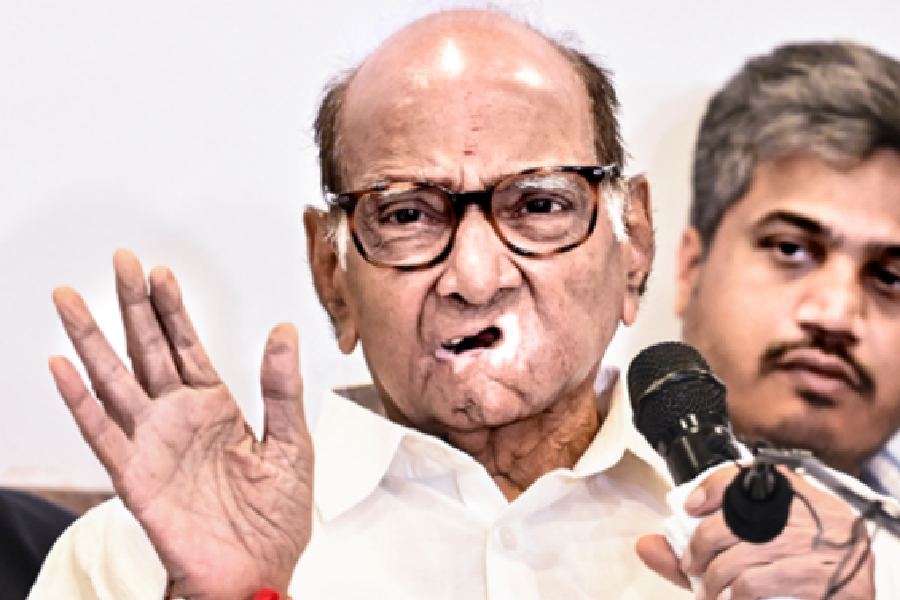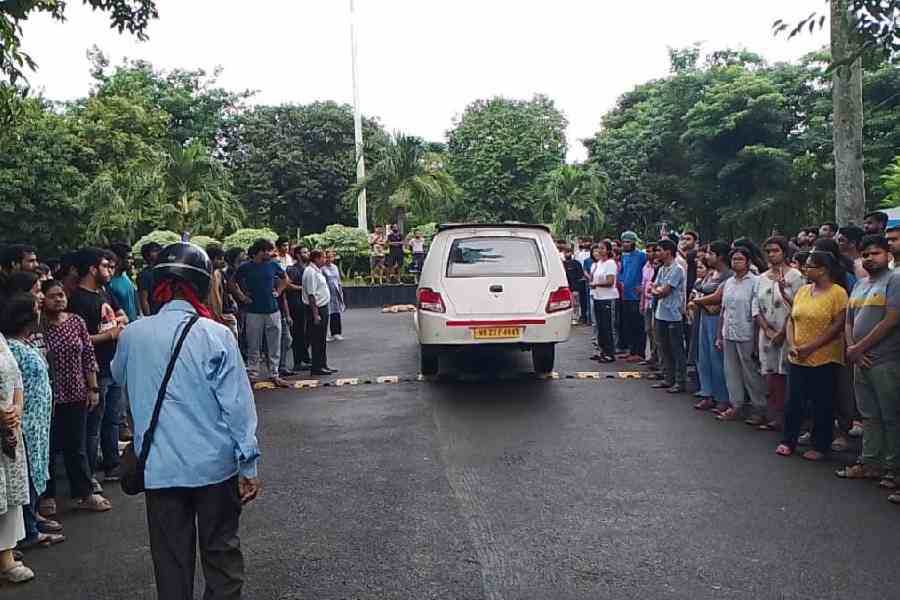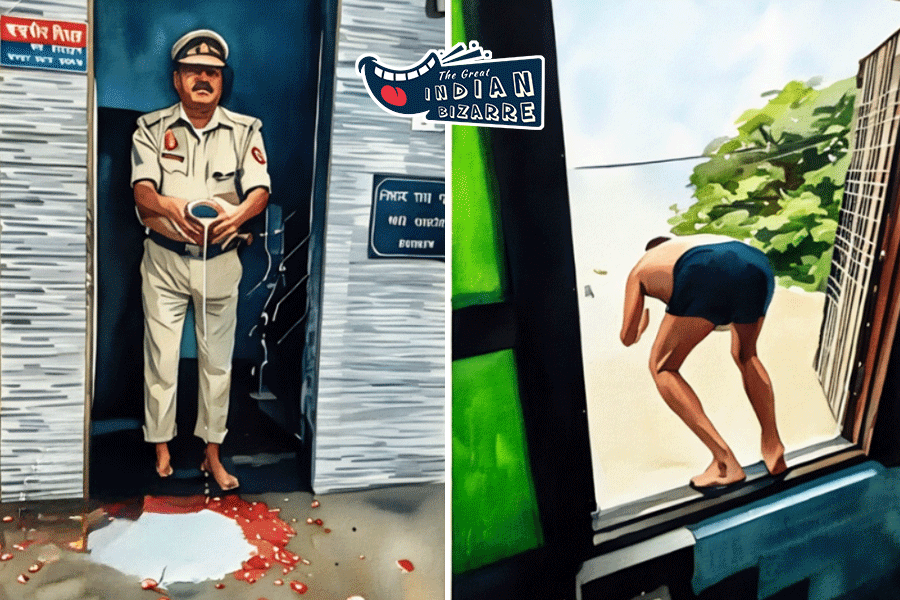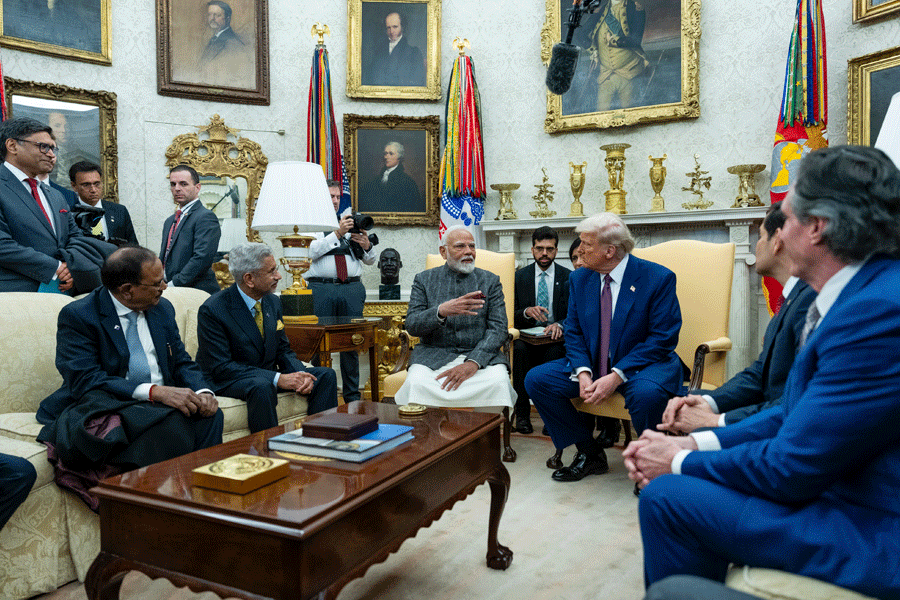 |
 |
 |
| Kishore Chatterjee in his room and two of his doodles. A Telegraph picture |
Kishore Chatterjee left an impression of his eccentric and whimsical personality on his paintings and drawings, and even on the flat in Ballygunge that he shared with his wife Maitreyee. The walls of its entrance are covered with paintings of Takai, the pesky old dog that used to keep them company. The flat is still crammed with paintings and art objects the couple passionately collected all their lives.
The walls of the tiny room in which he worked are crowded from ceiling to floor with the innumerable paintings and linocuts he created throughout his career as an artist. During his last years he had given up writing art reviews so that nobody could point a finger at him, and he could practise art single-mindedly. If one called him in the morning one was sure to get an earful of Western classical music playing full blast.
Music, art and cricket were the three passions of his life, and he had once almost wiped out his entire savings on buying music CDs that he found irresistible.
Chatterjee had participated in quite a few shows in the city, and his paintings of curious, quaint and odd human beings, birds and beasts charmed many. But he was still an outsider — he rarely found buyers — although he had been a part of the city’s artistic milieu from birth.
Kishore Chatterjee was born on August 2, 1938, at the joint family Beniapukur home, and his grandmother was Sunayani Debi. She was the sister of Abanindranath and Gaganendranath and was herself a renowned artist. It was a musical family. His grandmother sang, and so did his cousins during Dol festivities and weddings.
He was also lucky enough to have Meera Mukherjee, the leading sculptor, as his aunt by marriage. An accomplished singer that she was herself, she used to give Chatterjee occasional lessons in Rabindrasangeet. She had introduced him to her guru Bimala Prasad Chattopadhyay, who gave him lessons in breathing technique. This helped when last year he recorded his only album of Rabindrasangeet titled Udashi Hawa. He had an expressive though not a powerful voice. He acknowledged his indebtedness to both and also to Suchitra Mitra, who had briefly taken him under her wing.
Chatterjee was sent to Doon School, but unable to put up with its strict regimen, he ran away from there. But not before he had discovered the two loves of his life — art and music.
The painter, Sudhir Khastagir, was the art teacher there, and he introduced him to the joys of painting and Rabindrasangeet. He caught the classical Western music bug from a Parsi boy who used to play his vinyl records. Much later, Chatterjee came to the realisation that the exotic piece his classmate played was actually Rimsky-Korsakov’s Scheherazade.
After graduating from St. Xavier’s College, he joined Clarion, the ad agency, quite reluctantly. He would doodle all the while, and hum bars of music, particularly Beethoven’s Fifth, that caught the ear of a colleague who would be his future wife. He had little patience for Maitreyee Chatterjee’s women’s right activism, but there was never any conflict of interest, and he would type out her music reviews, albeit protesting loudly.
Formal training either in art or music eluded him. He had joined the Indian Art College and Rathin Maitra’s Sketch Club, if only for a while. He tried to take piano lessons but gave that up too. But after he gave a well-attended lecture at Max Mueller Bhavan on the occasion of Beethoven’s bicentenary, he started taking art and music appreciation courses at the Birla Academy of Art and Culture, and thereafter, began to give talks at the Calcutta School of Music.
Sagarmoy Ghosh had invited him to contribute on Western classical music for Desh, and he wrote five Bengali books for children meant to demystify both music and art.
As a token of his lifelong love, he published Beethoven and Friends two years ago, and before his death on June 13, he was working on an essay on the symbolism of certain words in Tagore. His work remains unfinished, but he lives on in the memory of his innumerable friends and the young artists he encouraged to just keep going.











